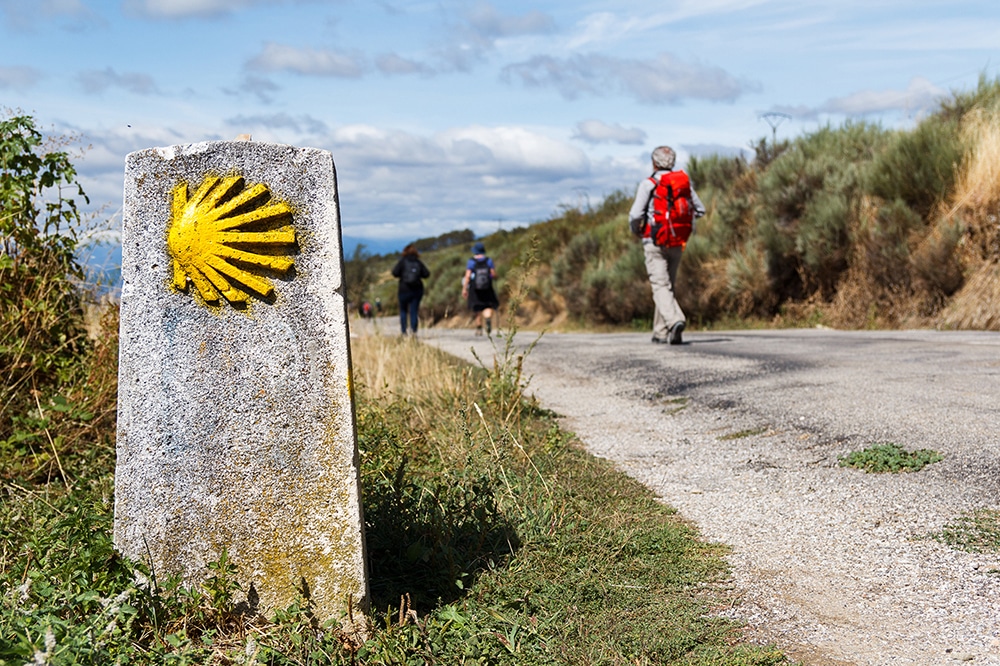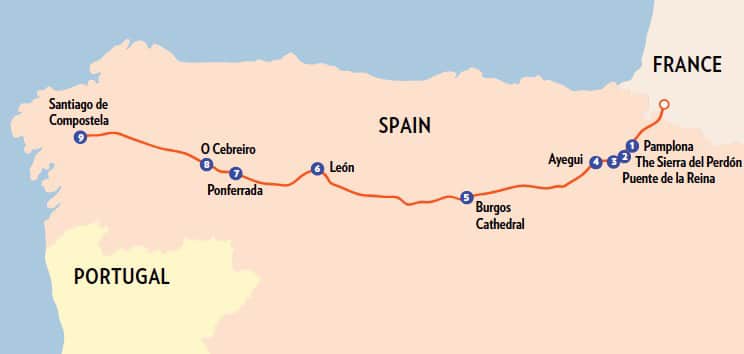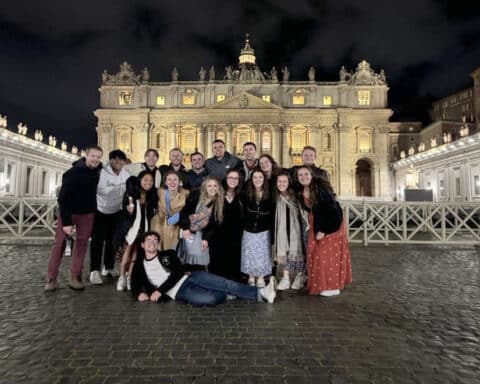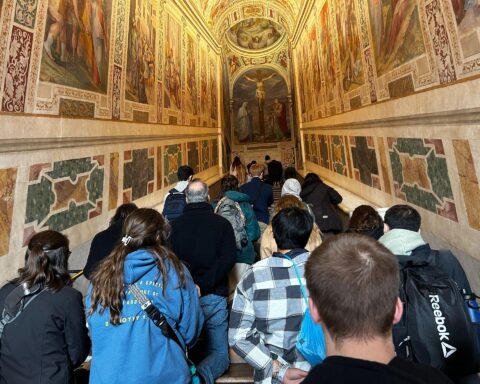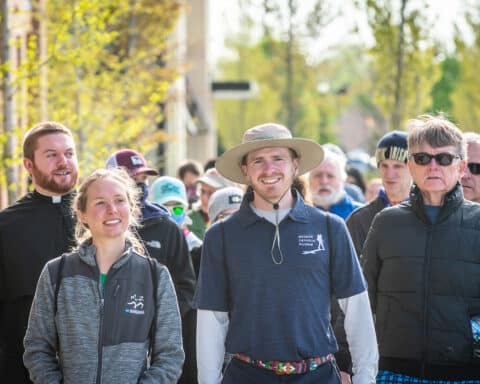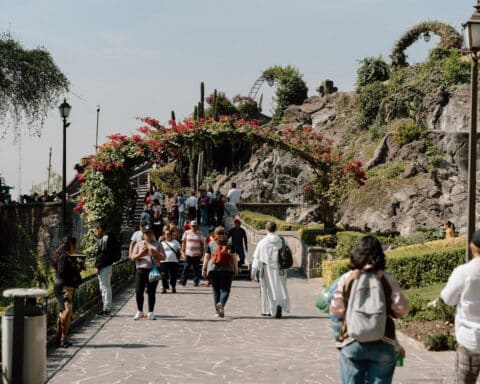If life is a journey, then the Camino de Santiago is the ultimate metaphor.
“A friend once told me that once you realize everything you need in life fits in a pack on your back, life becomes a lot easier, except for the realization that a lot of what we have in life is a burden,” said Matt Shepardson, who has walked the Camino three times in the last seven years.
“The most prominent experience I’ve ever had in my life is hiking the Camino,” Shepardson, 57, a retired airline pilot who lives northwest of Philadelphia, told Our Sunday Visitor. Shepardson said he hopes to walk The Way of St. James for a fourth time.
“It’s become such a part of my existence, there isn’t a day that goes by that I don’t think about something related to the Camino,” he said.

Camino de Santiago. Photo courtesy of Greg Daly
For more than a thousand years, pilgrims have walked hundreds of miles through the countryside in France, Western Europe and the Iberian Peninsula to venerate what tradition holds are the relics of St. James the Great in the Santiago de Compostela Cathedral in the Galicia region of Spain.
Shortly after the relics were discovered in the ninth century, the Camino became a major pilgrimage route. In medieval Europe, countless pilgrims made Santiago one of Christendom’s great pilgrimage destinations, alongside Jerusalem and Rome. St. Francis of Assisi himself is said to have walked the Camino from Italy.
The Camino de Santiago attracts more than 200,000 pilgrims a year from all over the world. Many are Christians, but countless others come from different faith traditions or none at all. What they often share in common is a search for meaning and clarity, which have become increasingly difficult to find in secular modernity.
“People on The Way are searching for ‘the more,’ not more material, but something that’s beyond this life, because they know they’re made for something greater,” said Lisa Gulino, a parish employee in Maine who walked the Camino in 2014.
Gulino, 57, who facilitates classes for the University of Notre Dame’s STEP program, told Our Sunday Visitor that she walked the Camino to reflect on her life as she turned 50 and as she hit a milestone of working 30 years in parish and diocesan lay ministry. She also wanted to commemorate the Year of Faith that Pope Benedict XVI declared from 2012 to 2013, in which he asked the faithful to reflect on their lives as disciples.
“My friends would talk about it, but I didn’t really feel called to do the Camino until the Year of Faith,” Gulino said. She carried six pounds of prayer intentions in envelopes during her Camino, which she began at O Cebreiro, a tiny Spanish village where a Eucharistic miracle occurred in 1300.
A lesson in humanity
The Camino de Santiago actually refers to several routes in Spain, France and Portugal that end at the cathedral in Santiago, Spain. The most popular route is the French Way — the Camino Frances — which attracts about two-thirds of the pilgrims every year.
The Camino Frances starts just over the border from Spain in St.-Jean-Pied-de-Port, located in southwestern France in the Pyrenean foothills. From there, the 500-mile Camino winds through four of Spain’s 15 regions.
“It’s a long route,” said Shepardson, who like many in the last decade was inspired to walk the Camino after watching “The Way,” the 2011 movie about the Camino de Santiago de Compostela that starred actor Martin Sheen and was directed by his son, Emilio Estevez.
“It was one of those things in faith, the inspiration, it just wouldn’t go away,” said Shepardson, who was still working at the time and had two teenage boys at home. Two years later, after getting time off work and buying hiking equipment, Shepardson was on his way to Europe.
“The Way works great as a reference for about the first week of the Camino,” he said “By the end of the second week, the actual experience brings you so far past what the two-dimension of a movie can communicate.”
Still, the film captures some slices of life along the Camino pretty well, most notably the camaraderie and friendships that develop between pilgrims throughout the entire six to seven weeks that they’re journeying through the Pyrenees and flatland regions of Spain.
“There were so many personalities,” said Jason Steidl, 36, of Brooklyn, New York, who walked the Camino in the summer of 2011.
“The friends I made on the trip were from Australia, Denmark, Germany and Italy. You really do make an international group of friends. Those relationships were incredibly special to me. I’m still in contact with a lot of those folks,” said Steidl, a visiting assistant professor of religious studies at St. Joseph’s College in New York. Steidl told Our Sunday Visitor that some of the people he drew closest to during the Camino were atheists or secular in their outlook.
“A lot of people are doing the Camino for many different reasons,” he said. “For me, the diversity of perspectives really enriched the Camino. We could bounce ideas off of each other and share our very different backgrounds.”
Fran Szpylczyn, 63, an office manager for the Church of the Immaculate Conception in Glenville, New York, told Our Sunday Visitor that “all pretense is stripped away” on the Camino as pilgrims walk alongside one another, bearing each other’s burdens, and often sleeping in the same “albergues,” or pilgrim hostels.
“There’s no artifice. People are snoring, farting. … One guy snored like you could not imagine. This was like seismic activity snoring,” said Szpylczyn, who walked the Camino in the fall of 2016.
Steidl added that one realizes “how human we all are” when walking the Camino.
“Staying in the albergues, you’re very close to other people, sometimes sleeping just a few feet from other people,” Steidl said. “You know, people make sounds. People have bodily functions going on. People snore. People smell. It’s just a very human incarnational experience, beautiful in some ways but also sometimes very challenging.”
Over the course of the Camino, Steidl said he learned to avoid sleeping in the same room as a Hungarian woman who snored loudly. Szpylczyn mentioned one woman who developed a reputation among other pilgrims as “the annoying, bossy Italian lady.”
“You see all these different personalities, everybody is just kind of thrown together, like a river of people moving along,” Szpylczyn said. “But you know, everybody’s seeking something when they’re on Camino.”

Camino de Santiago in 2016. Photo courtesy of Fran Szpylczyn
Opportunity for discernment
For Michael Rogers, 40, a legislative aide at the Massachusetts State House in Boston, walking the Camino in 2014 and 2017 gave him the clarity he needed to discern his vocation.
“There were things I wanted to think and pray about,” said Rogers, who was an ordained Jesuit priest when he traveled to St.-Jean-Pied-de-Port in 2014.
Walking the Camino in two stages — he had to stop in 2014 because of bad blisters on his feet — gave him the courage to leave the Jesuits and seek laicization after realizing that he had not been allowed to discern his vocation for himself, and that he had been effectively “pushed” into the priesthood and religious life. However, in an interview with Our Sunday Visitor, Rogers emphasized that his leaving the order was not acrimonious and that he still loves and has a good relationship with the Jesuits.
“Right now, the road’s open,” Rogers said. “I know what the next destination is, but I don’t necessarily know what each stop along the way looks like. That’s a lesson you learn on the Camino.”

The Camino also gave Greg Daly the clarity he needed to see that the life of a Dominican friar was not his life’s calling.
“The Camino for me became a good opportunity to take five or six weeks to think. But in the end, I did a lot less thinking than I thought I would and a lot more — I know it’s a cliche — just being,” said Daly, 46, the editor of Leaven, a new digital magazine for Irish Catholics.
Daly, who lives north of Dublin, Ireland, told Our Sunday Visitor that he had been a Dominican novice in the months before walking the Camino in May and June of 2014. He noticed that many people on The Way were at various transition points in their lives.
“More than anything, there were people who were there in between stuff, whether they were in between jobs, just retired, just finished college. There were a lot of people reconsidering things, and that’s where I was. I had been gearing up for religious life for years, and it hadn’t worked out,” Daly said.
Walking everyday with a friend, Daly would say the Rosary as he hiked through the countryside in France and Spain. He was mindful of the countless others who had walked and prayed those same paths over the previous millennia.
“You’re still walking a route that has been hallowed by century upon century of people praying, people hurting, people sharing their physical sustenance, their prayers, their stories,” Daly said. “It’s almost like wearing down a spiritual footpath that has been smoothed out by all that humanity in search of divinity.”
| POPULAR PILGRIM STOPS ALONG THE CAMINO DE SANTIAGO |
|---|
|
1. Pamplona
The capital of Spain’s Navarra region, the city of Pamplona is well known for its famous San Fermín festival — the Running of the Bulls — each July 6-14. The festival celebrates the third-century bishop of Pamplona, who, tradition holds, was martyred by being dragged to death with angry bulls running after him. 2. The Sierra del Perdón
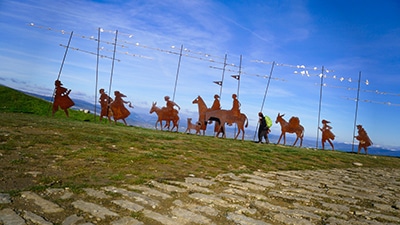 Camino pilgrims often climb the Alto del Perdón near Pamplona. At the top, besides the spectacular views of rolling green mountains and valleys, is an iconic row of iron pilgrim statues, complete with children, dogs and donkeys. 3. Puente de la Reina
The Camino passes through the main street of Puente la Reina, a small village in northern Spain. To resume their Camino, pilgrims walk across an old medieval bridge, known as the Puente Romanico. Queen Muniadona, the wife of King Sancho III, built the bridge in the 11th century for pilgrims on their way to Santiago de Compostela. 4. Ayegui
This town in the northern Spanish province of Navarre is perhaps best known for a fountain, located next to the Monastery of Iratxe, that dispenses real wine. Camino pilgrims as far back as the 12 century were known to stop in the village to refresh themselves with the monastery’s vino. 5. Burgos Cathedral
The Cathedral de Santa María de Burgos is one of the most renowned cathedrals in Spain. Construction on the Gothic structure began in 1221. UNESCO declared the cathedral a World Heritage Site in 1984. 6. León
The capital city of the Castilla y León region. Leon’s 13th-century Gothic cathedral — built on the site of second-century Roman baths — is renowned for its stained-glass windows that saturate the interior to such an extent that pilgrims have said it is as if the cathedral is constructed of light and color, not stone. The cathedral has perhaps the best preserved collection of medieval stained glass in Europe. 7. Ponferrada
Ponferrada is the last major town on the Camino Frances before pilgrims reach Santiago de Compostela. In 1178, King Ferdinand II of León presented Ponferrada to the Knights Templar to thank them for protecting pilgrims traveling through the region on their way to Santiago de Compostela. The city’s Templar castle still rises above the River Sil, dominating the city’s historic quarter. 8. O Cebreiro
 The tiny Spanish village of O Cebreiro sits on the border between the regions of Castilla y León and Galicia. In 1300, a Eucharistic miracle reportedly occurred here while a Benedictine priest was celebrating Mass in a chapel in O’Cebreiro’s convent church. The Eucharistic host changed to flesh, and the wine, which turned into blood, was expelled from the chalice, staining the corporal. In the 15th century, Queen Isabella had a shrine made to hold the host, chalice and paten, which to this day is still venerated by pilgrims. 9. Cathedral of Santiago de Compostela
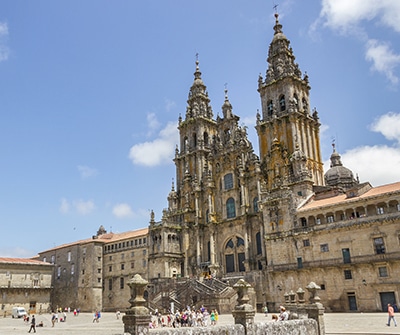 The cathedral in Santiago, the traditional end of the Camino pilgrimage, is a Romanesque structure, with later Gothic and Baroque additions that reflect the historical epochs it has experienced. The cathedral’s renowned 12th century Pórtico da Gloria — “Portico of the Glory” in Galician — is designed as a porchway with three arches with carvings that portray the Final Judgement. The cathedral’s dome also features a pulley mechanism to swing the Botafumeiro, the famous 180-pound thurible that may be the largest censer in the world. |
Physical challenges
Those paths that have been worn through the Spanish countryside were not done so easily. Walking 500 miles in six weeks, sometimes more than 20 miles a day, is not an easy physical task, even for young people who are relatively in good shape.
“The Camino can undo people who are marathon runners and who are really healthy,” said Steidl, who was a 26-year-old runner when he walked the Camino in June and July of 2011. Being young and in good shape didn’t stop him from getting painful blisters on his feet.
“Here I was, really healthy, a runner, and my feet were getting destroyed in my own shoes. That was the most discouraging thing to me. The pain was just incredible,” said Steidl, who developed knee and back problems as he adjusted his walking to avoid stepping on his blisters. Steidl’s young body healed and adapted to the Camino’s physical demands.
“It was an experience that brought me into contact with my physical limitations,” Steidl said. “I realized how embodying an experience it is. I realized that I had to feed my body. I had to sleep a lot each night, otherwise my body would break down. I had to take care of myself at each step of the way in order to complete the journey.”
The physical challenges go beyond pain and fatigue. Pilgrims often have to walk in cold rain and bone-biting wind. There are scorching days where the sun is out and the temperature reaches the high 90s, forcing pilgrims to drink water or risk heat stroke.

“It was physically tough,” said Daly, who recalled one day after walking in freezing rain. He sat shivering in a town’s marketplace, eating dinner outside a restaurant. A waitress walked outside and put a blanket around his shoulders.
“And then there were some days where it felt like a walk in the park,” Daly said. “You’d be tired at the end of it, but it’d be a happy tired.”
Meanwhile, Rogers’ blisters were so bad that he had to abandon his 2014 Camino at Burgos, Spain. Looking back, Rogers said he should have prepared for the pilgrimage. Before returning to Spain in 2017, Rogers hit the gym.
“Every day was leg day,” said Rogers, who also went out for long walks while wearing a weighted vest. He added that the physical preparation for the Camino is also about knowing what you do not need when you’re walking The Way.
“Part of it is saying to yourself, ‘You know, I really don’t need to carry a 30 pound pack,’ and cutting it down to the bare essentials,” Rogers said. “Living out the bare essentials is part of the grace, realizing you don’t need much more than a change of clothes, some toiletries and water.”
Shepardson, the retired airline pilot from Pennsylvania, said he learned very early on in his first Camino that he was carrying “way too much” in his pack.
“The Camino is a great pilgrimage for realizing how little you need,” Shepardson said, adding that it was amazing to see all the items pilgrims left behind in the hostels that first week on the road.
“The Camino is a great way to cleanse spiritually, mentally, physically, emotionally, to just let go of all that excess baggage,” he said.
Ending with communion
In the journey’s final kilometers, the Camino nears its spiritual crescendo as pilgrims arrive on the outskirts of Santiago and begin to see the spires of the Santiago de Compostela Cathedral. By this point, the roads are jammed with pilgrims, including those who walked the minimum 100 kilometers to be given credit for completing the Camino.
“At that point, you know you’re getting closer. You’re happy, but also sad because it’s coming to an end,” Szpylczyn said. “There’s just this intense feeling. You come around a bend, and then you’re in this plaza. It’s so emotional.”
Arriving at Santiago, Daly said he and his friend finished praying their Rosary just as they walked through a tunnel and emerged in front of the cathedral.
“It sounds scripted, but it happened exactly that way,” he said. “The whole thing was transformative. It’s a bit like the end of the Chronicles of Narnia, where you’re spotting people you’ve met along the way, and now they’re radiantly happy. The sheer joy that was overflowing, I’ve never seen the likes of it.”
A common experience for pilgrims arriving at Santiago and walking to the cathedral for Mass is seeing all the people they had met along the way over the previous six weeks. In many cases, pilgrims are reunited after not having seen each other since the first week or two on the Camino.
Gulino, the parish employee in Maine, said she bumped into eight people in Santiago whom she had met weeks earlier on the Camino. Later seeing them at the pilgrim’s Mass in the cathedral, Gulino thought of the Communion of Saints.
“To me, it was all symbolic of how, when we come to the Lord’s house, we will see those that we have loved, those whom we have served, and I think we’ll have a sense of how we have helped people to grow in their own faith life,” Gulino said.
Seeing the famous giant thurible swinging inside the cathedral — which was shown in the movie “The Way” — also made Rogers think of all the souls who have prayed in the cathedral over the centuries.
“You feel the connection to people who have been there throughout the years when you finally get to the cathedral,” Rogers said. “You get a real sense of the history that surrounds you, and really it’s the Communion of Saints that surrounds you when you walk in there.”
Shepardson, who walked the Camino with his wife, Cindy, and their two sons in 2016, and then again with Cindy in 2019, said it is still “very emotional” to think about arriving at Santiago, walking into the cathedral, venerating the tomb of St. James, attending the pilgrim Mass and seeing the giant thurible, which is also known as the “Botafumeiro,” or “smoke expeller” in Galician.
“Every time I’ve walked the Camino, it’s been a very different emotional arrival,” said Shepardson, who added that he has already made the rosaries that he will pray with and hand out to other pilgrims the next time he walks The Way — “whenever that’s going to be,” said Shepardson.
Brian Fraga is a contributing editor for Our Sunday Visitor.
| CELEBRATING A HOLY YEAR |
|---|
| Because the feast of St. James (July 25) this year falls on a Sunday, 2021 is a jubilee year for pilgrims walking the Camino de Santiago.
This year, pilgrims who walk the Camino can obtain a plenary indulgence by walking through the Holy Door in the Cathedral of Santiago, praying for the pope, attending Mass and receiving the sacraments of Reconciliation and holy Communion. Given the jubilee year, which coincides with the easing of the novel coronavirus pandemic, more pilgrims from around the world are expected this year to walk the Camino and visit the cathedral in Santiago. The pilgrims are returning a year after COVID-19 restricted foreign and domestic travel in Spain. The Camino only saw about 50,000 pilgrims in 2020, a year after 340,000 people walked The Way, according to published reports. “The Way of St. James, in this sense, can help us. It is a space that helps us recover our inner peace, our stability, our spirit, which without doubt we all need, given the difficulties that we have in facing the pain and the ravages of the pandemic that sometimes leave us speechless,” Archbishop Julián Barrio of Santiago de Compostela told the Associated Press in June. The Santiago cathedral’s Holy Door — also known as the Door of Mercy or the Porta Santa — is opened the previous December for the Holy Year. In December 2020, Pope Francis wrote a letter to Archbishop Barrio to mark the opening of the Holy Door. In his letter, the pope wrote that all Christians are “a pilgrim people” who do not travel toward “a utopic ideal but rather a concrete goal.” “The pilgrim is capable of placing himself or herself in God’s hands, aware that the promised homeland is present in the one who wished to make camp amid his people, to guide their journey,” the pope wrote. Pope Francis also extended the Holy Year in Santiago to 2022 because of the pandemic. The Confraternity of St. James said it is the second such extension in nine centuries, the first being in 1937-38 because of the Spanish Civil War. “It is hoped that this decision will allow for a greater recovery period and celebration following the ongoing impact of the COVID-19 pandemic,” the Confraternity of St. James said in an online post. The Holy Year in Santiago dates back centuries. In 1122, Pope Calixtus II gave Compostela the privilege of granting a plenary indulgence to those who visited the shrine in the years when the saint’s day fell on a Sunday. That historical detail is recorded in Regis Aeterni, a papal bull issued by Pope Alexander III in 1179. |

